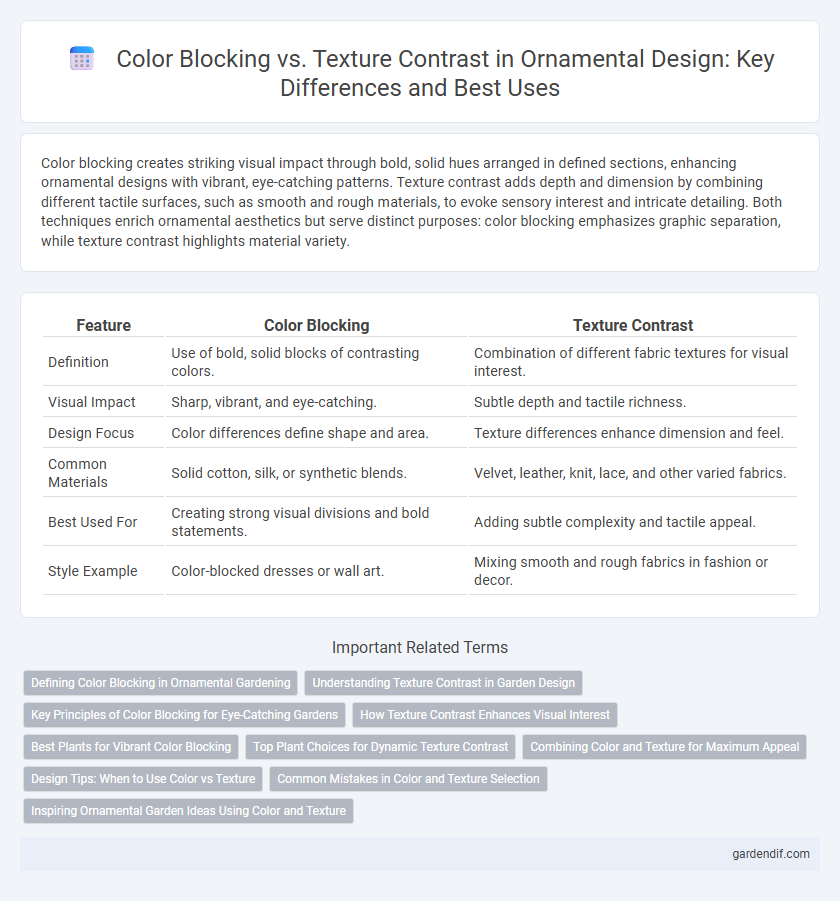
Color Blocking vs Texture Contrast Illustration
Color blocking creates striking visual impact through bold, solid hues arranged in defined sections, enhancing ornamental designs with vibrant, eye-catching patterns. Texture contrast adds depth and dimension by combining different tactile surfaces, such as smooth and rough materials, to evoke sensory interest and intricate detailing. Both techniques enrich ornamental aesthetics but serve distinct purposes: color blocking emphasizes graphic separation, while texture contrast highlights material variety.
Table of Comparison
| Feature | Color Blocking | Texture Contrast |
|---|---|---|
| Definition | Use of bold, solid blocks of contrasting colors. | Combination of different fabric textures for visual interest. |
| Visual Impact | Sharp, vibrant, and eye-catching. | Subtle depth and tactile richness. |
| Design Focus | Color differences define shape and area. | Texture differences enhance dimension and feel. |
| Common Materials | Solid cotton, silk, or synthetic blends. | Velvet, leather, knit, lace, and other varied fabrics. |
| Best Used For | Creating strong visual divisions and bold statements. | Adding subtle complexity and tactile appeal. |
| Style Example | Color-blocked dresses or wall art. | Mixing smooth and rough fabrics in fashion or decor. |
Defining Color Blocking in Ornamental Gardening
Color blocking in ornamental gardening involves grouping plants with bold, solid-colored foliage or flowers to create striking visual sections within a garden space. This technique emphasizes the use of distinct color zones that draw the eye and enhance the overall design by providing clear separations between areas. Unlike texture contrast, which relies on differences in leaf shape or surface, color blocking focuses strictly on vivid, uninterrupted hues for maximum impact.
Understanding Texture Contrast in Garden Design
Texture contrast in garden design enhances visual interest by pairing rough, coarse foliage with smooth, glossy leaves to create dynamic interplay. Combining diverse plant textures, such as spiky grasses alongside soft, feathery blooms, adds depth and dimension that color blocking alone cannot achieve. Strategic use of texture contrast guides the eye through the landscape, emphasizing structural elements and creating a balanced, engaging outdoor space.
Key Principles of Color Blocking for Eye-Catching Gardens
Color blocking in ornamental gardening relies on grouping vibrant, solid hues in distinct sections to create bold visual statements that captivate the eye. Strategic placement of complementary or analogous colors enhances contrast and depth, making garden features stand out while maintaining harmony. Emphasizing size variation and repetition within color blocks reinforces cohesiveness and guides visitors through the landscape effectively.
How Texture Contrast Enhances Visual Interest
Texture contrast enhances visual interest by adding depth and dimension to ornamental designs, creating a tactile appeal that color blocking alone cannot achieve. Combining smooth, rough, glossy, and matte surfaces stimulates the senses and guides the viewer's eye across the design. This strategic interplay of textures makes ornamental elements more dynamic and engaging.
Best Plants for Vibrant Color Blocking
Vibrant color blocking in ornamental gardening is best achieved with plants such as Coleus, Caladium, and Heuchera, which offer bold, contrasting foliage hues that create striking visual impact. Combining these with texture-contrasting plants like Lamb's Ear or Dusty Miller enhances dimension while maintaining a vivid palette. Strategic placement of these species maximizes vibrant color blocks, making gardens visually dynamic and engaging throughout the growing season.
Top Plant Choices for Dynamic Texture Contrast
Top plant choices for dynamic texture contrast include ferns, ornamental grasses, and succulents, which provide a variety of leaf shapes and surface textures. Incorporating plants like silver mound artemisia or lamb's ear adds soft, velvety foliage that contrasts sharply with the rigid, structured leaves of agave or yucca. Combining these textural differences enhances the visual interest and depth in ornamental garden designs.
Combining Color and Texture for Maximum Appeal
Combining color blocking with texture contrast amplifies ornamental appeal by creating dynamic visual layers that engage the eye. Bold, vibrant color blocks paired with varied textures like matte, glossy, or tactile fabrics generate a multidimensional effect that enhances spatial depth. Strategic use of complementary or analogous hues alongside contrasting textures elevates design impact, ensuring a vibrant yet harmonious aesthetic.
Design Tips: When to Use Color vs Texture
Color blocking enhances ornamental design by creating bold visual impact through distinct, vibrant hues, ideal for spaces that require clear focal points and dynamic energy. Texture contrast introduces depth and tactile interest, perfect for adding subtle sophistication and balancing monochromatic or minimalistic color schemes. Opt for color blocking to define areas or highlight key elements, while texture contrast works best to enrich surfaces and evoke sensory engagement in ornamental decor.
Common Mistakes in Color and Texture Selection
Common mistakes in ornamental design include confusing color blocking with texture contrast, leading to visually unbalanced spaces. Using clashing colors without considering the texture's influence can create discord instead of harmony. Selecting overly similar textures alongside bold color blocking often results in a lack of depth and visual interest.
Inspiring Ornamental Garden Ideas Using Color and Texture
In ornamental garden design, color blocking creates striking visual impact by grouping bold, contrasting hues that draw the eye and define distinct garden areas. Texture contrast enhances this effect by combining smooth, glossy foliage with rough, spiky plants, adding dynamic depth and tactile interest to the landscape. Using these techniques in tandem inspires unique garden compositions that balance vivid color zones with varied leaf and surface textures for an engaging sensory experience.
Color Blocking vs Texture Contrast Infographic

 gardendif.com
gardendif.com